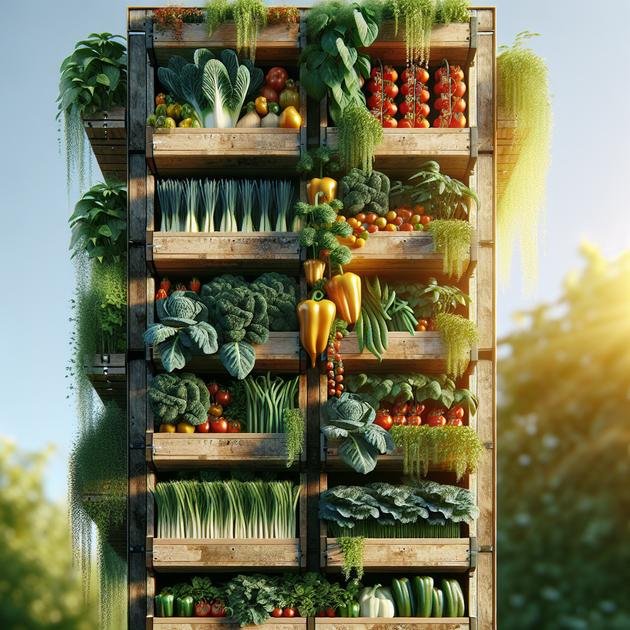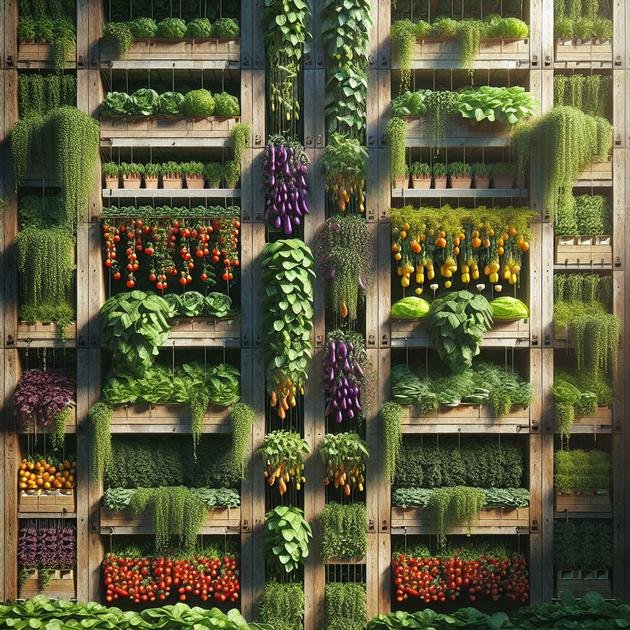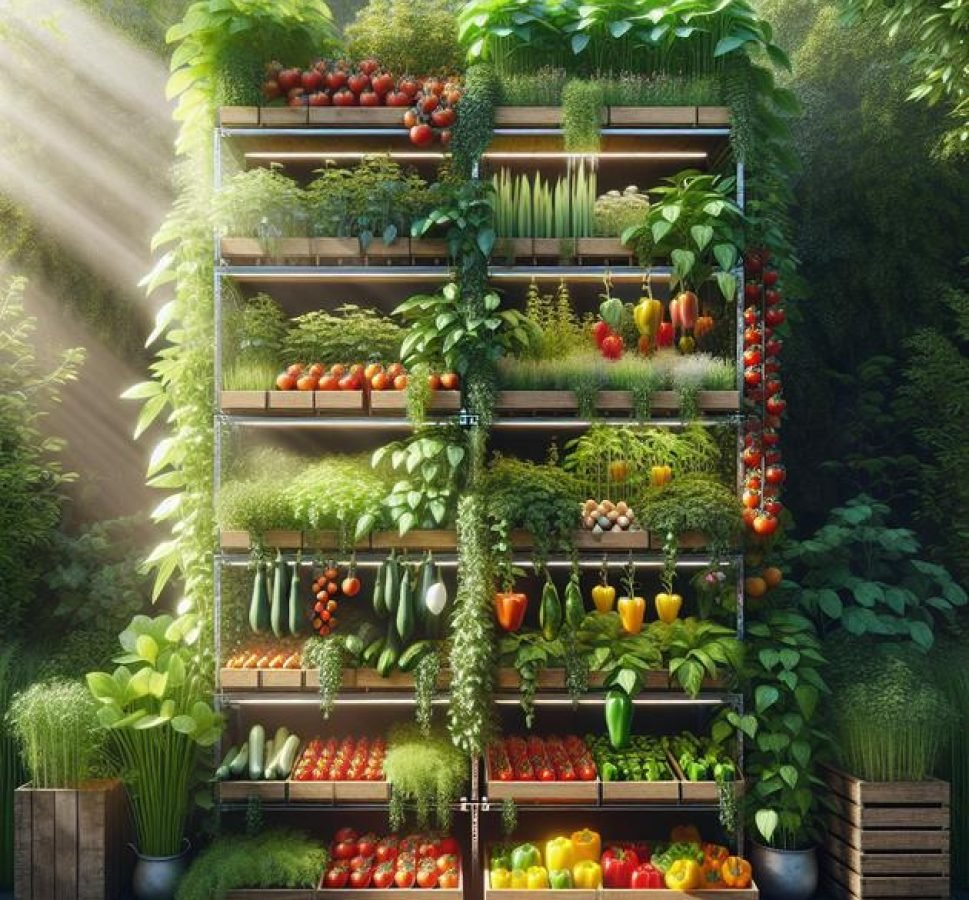A vertical vegetable garden maximizes small spaces by growing plants upward on structures like trellises or pockets, allowing efficient use of limited areas to grow vegetables and herbs while improving accessibility and air quality.
Have you ever thought about growing fresh veggies at home but felt limited by space? A vertical vegetable garden might be just the clever solution you need to turn a small corner into a vibrant green patch. Curious how it works? Let’s explore.
What is a vertical vegetable garden?
A vertical vegetable garden is a gardening technique where plants grow upward instead of spreading out over ground space. This method uses structures like trellises, stacked planters, or wall-mounted systems to support the plants. It’s perfect for small spaces such as balconies, patios, and urban homes where traditional gardening isn’t feasible.
By growing vegetables vertically, you save valuable ground space and can create a lush, productive garden even in tight areas. Common plants suitable for vertical gardens include tomatoes, beans, lettuce, herbs, and cucumbers. These plants either climb naturally or can be trained to grow upwards with the help of support systems.
Besides saving space, vertical gardens can improve air circulation around plants, reduce pest problems, and make maintenance tasks like watering and harvesting easier. They also add aesthetic appeal by turning bare walls or fences into vibrant green spaces.
Key Features of Vertical Vegetable Gardens
- Space-Saving: Utilizes vertical structures to maximize planting area.
- Plant Support: Uses trellises, shelves, or pockets to hold plants.
- Improved Growth Conditions: Better airflow and sunlight exposure.
- Accessibility: Easier to maintain and harvest.
Benefits of vertical gardening in small spaces
Vertical gardening offers several advantages, especially in small spaces. First, it maximizes the use of limited areas by growing plants upward instead of outward. This allows gardeners to cultivate more vegetables without needing a large yard or garden plot.
Another benefit is improved air circulation around the plants, which helps reduce the risk of pests and diseases. Plants growing vertically often receive better sunlight exposure since they aren’t shaded by other plants, boosting their growth and yield.
Vertical gardens also make gardening more accessible. They reduce the need to bend or kneel, making tasks like planting, watering, and harvesting easier and more comfortable. This can be particularly helpful for older gardeners or those with physical challenges.
Additionally, vertical gardens can enhance the aesthetic appeal of small spaces by turning bare walls or fences into lush green walls. This creates a pleasant and productive environment, even in urban apartments or patios.
Environmental and Practical Advantages
- Water Efficiency: Vertical systems can reduce water waste by directing water precisely where it’s needed.
- Space Optimization: Ideal for urban areas with limited outdoor space.
- Reduced Pest Problems: Better airflow discourages pests and fungal diseases.
- Enhanced Accessibility: Easier maintenance and harvesting at comfortable heights.
Choosing the right plants for vertical gardens
Choosing the right plants is key to a thriving vertical vegetable garden. Focus on plants that are naturally suited for vertical growth or can be trained to climb. Popular options include climbing beans, peas, cucumbers, and tomatoes because they have vines or tendrils that easily attach to supports.
Leafy greens like lettuce, spinach, and kale also do well in vertical gardens, especially when grown in stacked planters or pocket systems. Herbs such as basil, mint, and parsley are compact and add value by providing fresh flavors at arm’s reach.
When selecting plants, consider their growth habits, size, and sun requirements. For example, tomatoes need full sun and sturdy support, while leafy greens tolerate some shade and fit well in smaller containers.
Tips for Plant Selection
- Climbing plants: Beans, peas, cucumbers, tomatoes.
- Leafy greens: Lettuce, spinach, kale.
- Herbs: Basil, mint, parsley.
- Compact plants: Radishes, dwarf peppers.
Mixing plants with complementary growth patterns can optimize space and yield. For instance, pairing tall climbing plants with low-growing herbs maximizes vertical and horizontal space effectively.
Materials and tools needed to build a vertical garden

Building a vertical vegetable garden requires some basic materials and tools to ensure a sturdy and productive setup. The key materials typically include a frame or support structure, planting containers, and soil or growing medium.
Support structures can be made from wood, metal, plastic, or repurposed materials like pallets. Trellises, shelves, or hanging pockets are common options to hold the plants and allow them to grow upward.
For planting containers, consider pots, grow bags, or vertical planter pockets. Choose containers with proper drainage to prevent water buildup and root rot.
Essential Tools and Supplies
- Measuring tape: To measure your space and materials precisely.
- Drill and screws: For assembling frames and securing containers.
- Gardening gloves: To protect your hands while working.
- Potting soil: A high-quality mix suitable for vegetables.
- Watering can or hose: For easy watering of your vertical garden.
- Plant supports: Such as stakes or ties to guide climbing plants.
Having these materials and tools ready will help you create a functional and durable vertical garden, perfect for small spaces.
Step-by-step guide to setting up your vertical vegetable garden
Start by selecting a suitable location with good sunlight for at least 4-6 hours daily. Light is crucial for healthy plant growth. Measure the available space to decide the size of your vertical garden.
Step 1: Choose or build a sturdy support structure like a trellis, pallet, or vertical planter shelves. Ensure it is securely fixed to avoid tipping.
Step 2: Select containers or planting pockets with proper drainage holes. Fill them with nutrient-rich potting soil designed for vegetables.
Step 3: Plant your chosen vegetables considering their growth habits. Place climbing plants at the base of the structure to allow them to climb upwards. Smaller plants or herbs can be placed in pockets or shelves.
Step 4: Water the plants thoroughly right after planting. Maintain consistent watering, avoiding both waterlogging and drought stress.
Step 5: Support climbing plants with ties or clips to guide their growth along the structure. Prune plants regularly to encourage healthy growth and higher yields.
Maintenance Tips
- Check soil moisture every day, especially during hot weather.
- Use organic fertilizers every 4-6 weeks to replenish nutrients.
- Monitor for pests and diseases, and treat promptly if detected.
- Harvest vegetables regularly to promote continuous production.
How to care for plants in a vertical garden
Proper care is essential to keep your vertical vegetable garden healthy and productive. Start by watering consistently, as vertical gardens tend to dry out faster than traditional gardens. Use a watering can or drip irrigation system to ensure even moisture distribution.
Soil quality matters greatly; use nutrient-rich, well-draining potting mix. Fertilize the plants regularly with balanced organic fertilizers to replenish nutrients lost through frequent watering.
Monitor your plants for signs of stress, such as yellowing leaves or drooping stems, which can signal watering or nutrient problems. Check for pests and diseases often, and treat them promptly using natural or chemical methods safe for edible plants.
Additional Care Tips
- Pruning: Trim dead or yellowing leaves to encourage new growth and prevent disease.
- Support: Ensure climbing plants are tied securely to supports to grow properly.
- Sunlight: Rotate containers if needed to provide even light exposure.
- Temperature: Protect plants from extreme heat or cold with shade cloths or covers.
Watering tips for vertical vegetable gardens
Watering is crucial for the success of a vertical vegetable garden due to the limited soil volume and higher exposure to sun. It’s important to maintain consistent moisture without overwatering, which can lead to root rot.
Use a watering can with a narrow spout or a drip irrigation system to deliver water directly to the plant roots. This helps conserve water and prevents wetting the foliage, reducing the risk of fungal diseases.
Effective Watering Practices
- Frequency: Check soil moisture daily and water when the top inch feels dry.
- Time of day: Water early in the morning or late in the evening to minimize evaporation.
- Drainage: Ensure containers have adequate drainage holes to prevent waterlogging.
- Mulching: Apply organic mulch on soil surfaces to retain moisture.
Monitoring moisture levels closely is vital because vertical gardens can dry out faster than ground-level gardens, especially during hot or windy conditions. Adjust watering frequency accordingly to keep plants healthy and thriving.
Dealing with pests and diseases in vertical setups

Vertical gardens can be vulnerable to pests and diseases due to the close proximity of plants and limited airflow. Regular monitoring is crucial to catch any issues early and prevent serious damage.
Common pests include aphids, spider mites, whiteflies, and caterpillars. These insects feed on plant sap or leaves, weakening the plants and sometimes spreading diseases.
Diseases such as powdery mildew, root rot, and fungal infections may develop in vertical setups, especially if humidity is high or watering practices are poor.
Effective Pest and Disease Management
- Inspect plants regularly: Look for spots, discoloration, holes, or sticky residue on leaves.
- Promote good airflow: Space plants properly and prune crowded foliage.
- Use natural remedies: Apply neem oil, insecticidal soap, or introduce beneficial insects like ladybugs.
- Maintain cleanliness: Remove dead leaves and debris to reduce breeding grounds for pests.
- Water carefully: Avoid overwatering to prevent fungal growth and root rot.
Early intervention and consistent care help keep your vertical vegetable garden healthy and productive despite pest and disease challenges.
Maximizing sunlight in limited spaces
Maximizing sunlight is essential for a successful vertical vegetable garden, especially in small or shaded spaces. Position your garden where it can receive at least 4-6 hours of direct sunlight daily, as most vegetables require ample light to grow well.
Use reflective surfaces like light-colored walls or mirrors nearby to bounce more light onto your plants. This can help brighten shaded areas and improve photosynthesis.
When space is limited, arrange plants according to their light needs. Place sun-loving plants like tomatoes and peppers at the top or in the sunniest spots. Put shade-tolerant plants like lettuce or spinach lower down where less light reaches.
Additional Tips to Increase Sunlight Exposure
- Rotate plants periodically to ensure all sides receive equal sunlight.
- Prune dense foliage to avoid shading lower plants.
- Choose compact or dwarf varieties that don’t overshadow others.
- Avoid placing vertical gardens in fully shaded locations whenever possible.
Using vertical gardens to improve indoor air quality
Vertical gardens can significantly improve indoor air quality by increasing oxygen levels and filtering harmful pollutants. Plants absorb carbon dioxide and release fresh oxygen, making your indoor space feel fresher and more vibrant.
Certain vegetable and herb plants are especially effective at removing toxins and enhancing air quality. Examples include basil, spinach, lettuce, and mint. These plants help reduce airborne chemicals and increase humidity.
Using a vertical garden indoors also saves floor space while providing a natural green feature that promotes well-being. The presence of plants can reduce stress and improve mood.
Tips for Optimizing Air Quality Benefits
- Choose air-purifying plants appropriate for indoor conditions.
- Ensure adequate lighting—natural or grow lights—to keep plants healthy.
- Keep soil moist but not soggy to prevent mold growth.
- Regularly clean plant leaves to maximize photosynthesis and air filtration.
Integrating a vertical vegetable garden indoors can create a healthier living environment while providing fresh produce.
Creative DIY ideas for vertical vegetable gardens
Creating a vertical vegetable garden can be both practical and fun with some DIY creativity. Start by using recycled materials such as wooden pallets, old shoe organizers, or plastic crates to build your garden structure. These options are eco-friendly and cost-effective.
Pallets can be hung on walls and filled with soil in the gaps to grow herbs and small vegetables. Shoe organizers with pockets work well for lightweight plants like lettuce, spinach, and herbs and can be easily hung on doors or fences.
Other DIY Ideas
- Recycled gutter planters: Attach old gutters horizontally to a wall for planting small vegetable rows.
- Hanging jars or bottles: Use recycled jars or plastic bottles suspended with ropes for a charming vertical herb garden.
- Stacked pots or crates: Create tiered planting by stacking containers securely to save space and add visual interest.
- Wire mesh or trellis: Build climbing supports for beans or cucumbers using wire mesh attached to a frame.
These creative ideas not only maximize your growing space but also add a personal touch to your vertical garden, making it unique and enjoyable to maintain.
Common mistakes to avoid when gardening vertically

Gardening vertically offers many benefits, but certain common mistakes can hinder your garden’s success. Avoid overcrowding plants, which can reduce airflow and promote diseases. Give each plant enough space to grow and spread.
Overwatering is another frequent error. Vertical gardens often have limited soil volume, so excess water can lead to root rot. Water consistently but avoid waterlogging.
Choosing the wrong plants for vertical gardening can cause poor growth. Select plants suited for upward growth or compact varieties.
Other Mistakes to Avoid
- Ignoring sunlight requirements: Place your garden where plants get enough light daily.
- Using poor soil: Avoid heavy or nutrient-poor soil; use quality potting mix.
- Neglecting support structures: Ensure climbing plants have secure trellises or stakes.
- Failing to monitor pests: Regularly check plants to catch infestations early.
Avoiding these mistakes will help your vertical vegetable garden thrive in small spaces.
Seasonal maintenance and plant rotation strategies
Seasonal maintenance is vital to keep your vertical vegetable garden healthy year-round. Begin by removing dead or diseased plants at the end of each growing season to prevent pests and diseases from lingering.
Plant rotation is an important strategy where you change the types of vegetables grown in each spot every season. This practice helps avoid soil nutrient depletion and reduces the buildup of pests and diseases common to specific plant families.
During seasonal transitions, refresh the soil by adding compost or organic fertilizers to restore nutrients. Check and repair any support structures to ensure they remain strong for the next planting.
Tips for Seasonal Care and Rotation
- Plan your crop rotation: Rotate between leafy greens, root vegetables, and fruiting plants.
- Clean and sanitize containers: Wash pots and containers to reduce disease risk.
- Adjust watering: Modify watering schedules based on seasonal weather changes.
- Mulch: Apply mulch to protect soil during cold months and retain moisture in hot seasons.
These strategies promote a resilient vertical garden that yields fresh vegetables effectively across different seasons.
In Conclusion
Building and maintaining a vertical vegetable garden is a smart way to grow fresh produce in small spaces. By choosing the right plants, caring for them properly, and following good gardening practices like seasonal maintenance and plant rotation, you can enjoy a productive and healthy garden year-round.
Vertical gardening also brings benefits beyond food production, like improving air quality and adding beauty to your living space. With some creativity and attention to detail, anyone can create a thriving vertical vegetable garden that fits their lifestyle and space.
Start your vertical gardening journey today and watch your small space transform into a lush, green oasis full of homegrown vegetables.





